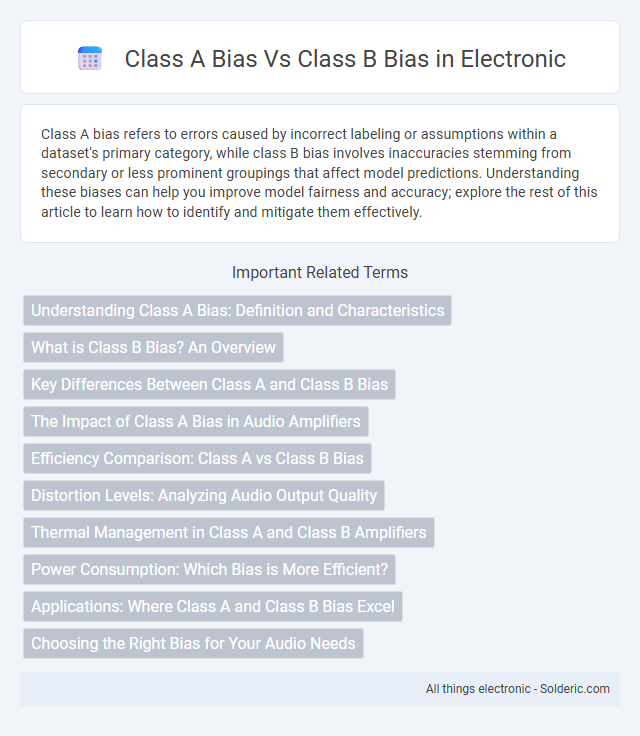Class A bias refers to errors caused by incorrect labeling or assumptions within a dataset's primary category, while class B bias involves inaccuracies stemming from secondary or less prominent groupings that affect model predictions. Understanding these biases can help you improve model fairness and accuracy; explore the rest of this article to learn how to identify and mitigate them effectively.
Comparison Table
| Feature | Class A Bias | Class B Bias |
|---|---|---|
| Definition | Bias voltage applied directly to the transistor base | Bias voltage applied to the transistor base via a voltage divider |
| Bias Stability | Less stable, sensitive to temperature and transistor variations | More stable due to voltage division and feedback |
| Power Efficiency | Lower efficiency, continuous conduction | Higher efficiency, conduction during half cycle |
| Application | Used in Class A amplifier circuits for linear amplification | Used in Class B amplifier circuits for push-pull amplification |
| Quiescent Current | High quiescent current | Zero or minimal quiescent current |
Understanding Class A Bias: Definition and Characteristics
Class A bias refers to a type of cognitive or systemic bias characterized by strong, often unconscious preferences that significantly impact decision-making processes and outcomes. It typically manifests in scenarios where deeply ingrained stereotypes or assumptions about specific groups lead to skewed judgments, affecting fairness and objectivity. Understanding Class A bias helps you identify and mitigate these powerful influences to promote more equitable and accurate assessments in various contexts.
What is Class B Bias? An Overview
Class B bias is a specific type of amplifier input offset commonly found in transistor circuits, characterized by the distinct voltage threshold needed to switch between transistor conduction states. This bias type ensures minimal crossover distortion in push-pull amplifier configurations by allowing two transistors to alternately conduct during their respective halves of the input signal cycle. Understanding Class B bias is crucial for optimizing your audio amplifier designs to achieve efficient power usage with reduced signal distortion.
Key Differences Between Class A and Class B Bias
Class A bias refers to a strong, often unconscious preference or stereotype towards characteristics such as race, gender, or age, which significantly impacts decision-making and behavior. Class B bias is typically more subtle and may arise from cultural or situational factors, influencing perceptions and interactions with less overt consequences. Understanding these differences helps you recognize and address the varying impacts of biases in social and professional contexts.
The Impact of Class A Bias in Audio Amplifiers
Class A bias in audio amplifiers delivers continuous current flow through the output transistors, resulting in superior linearity and minimal distortion compared to Class B bias, which only conducts during half of the input signal cycle. This continuous operation in Class A amplifiers enhances audio fidelity and produces a warmer, more natural sound, making it ideal for high-quality audio reproduction. You benefit from improved clarity and detail in your sound system with Class A bias, despite its higher power consumption and heat generation.
Efficiency Comparison: Class A vs Class B Bias
Class A bias transistors typically offer higher efficiency due to continuous conduction, resulting in lower distortion but increased power consumption and heat generation. Class B bias improves efficiency by allowing transistors to conduct only during half of the input signal cycle, reducing power loss and heat but potentially introducing crossover distortion. Your choice between Class A and Class B bias depends on the balance you prioritize between audio fidelity and energy efficiency.
Distortion Levels: Analyzing Audio Output Quality
Class A bias offers ultra-low distortion levels, typically below 0.1%, ensuring pristine audio output quality ideal for audiophiles seeking pure sound reproduction. In comparison, Class B bias exhibits higher distortion, often around 1-2%, due to crossover distortion inherent in its push-pull design, which can degrade audio clarity. Your choice between Class A and Class B bias impacts how accurately audio signals are amplified, affecting overall listening experience.
Thermal Management in Class A and Class B Amplifiers
Thermal management in Class A amplifiers is crucial due to continuous high current flow, which generates significant heat requiring substantial heat sinks and efficient cooling systems. In contrast, Class B amplifiers operate with current only during signal peaks, resulting in lower heat generation and simpler thermal management. Your choice between these amplifier classes impacts the design complexity and cooling solutions needed for optimal performance and longevity.
Power Consumption: Which Bias is More Efficient?
Class A bias consumes significantly more power as it continuously draws current regardless of input signal presence, resulting in higher energy usage and heat generation. Class B bias operates more efficiently by only conducting current during positive or negative halves of the input signal, reducing power consumption and heat dissipation. Your choice depends on balancing efficiency with linearity needs, as Class B offers better power efficiency while Class A provides superior signal fidelity.
Applications: Where Class A and Class B Bias Excel
Class A bias excels in applications requiring high precision and consistency, such as medical diagnostics and financial risk assessment, where minimizing false positives is critical. Class B bias performs better in scenarios demanding adaptability and generalization, including recommendation systems and natural language processing, where handling diverse inputs is essential. Understanding the distinct strengths of each bias type enables optimized model selection tailored to specific domain requirements.
Choosing the Right Bias for Your Audio Needs
Class A bias offers constant current flow with minimal distortion, ideal for audiophiles seeking high-fidelity sound and smooth audio reproduction. Class B bias operates efficiently by conducting only during half the audio waveform, reducing power consumption but potentially introducing crossover distortion. Your choice depends on prioritizing either pristine audio quality with Class A or energy efficiency with Class B, matching your specific audio needs.
class a bias vs class b bias Infographic

 solderic.com
solderic.com